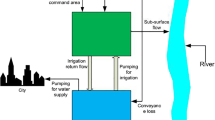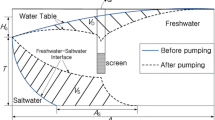Abstract
This study proposes an integrated approach to assess the performance of a conjunctive-use surface and subsurface water system. System dynamics serves as the main framework of the proposed conjunctive-use model, simulating the interaction between surface and subsurface water and the impact of various conjunctive-use alternatives on the system as a whole. This study assumes natural groundwater recharge as a water source to the system, and estimates its volume using geographic information system (GIS) tools, a groundwater simulation model (MODFLOW), and a parameter identification model (UCODE). This study assesses various conjunctive-use alternatives and analyzes the frequency of water shortage to illustrate how the recharge rate affects water supply reliability under the conjunctive-use framework. Simulation results indicate that conjunctive-use with artificial recharge indeed reduces the frequency of extreme water shortages. Results also reveal that artificial recharge is necessary to maintain groundwater conservation without overusing river flow. Although this study focuses on southern Taiwan, the proposed concepts and procedure are applicable to other areas with a similar conjunctive-use framework.
Similar content being viewed by others
References
Ahmad S, Simonovic SP (2000) System dynamics modeling of reservoir operations for flood management. J Comput Civ Eng 14(3):190–198
Assessment of China Water Resources (Chinese) (1986) The hydrology agency. Ministry of Water Resources of the Mainland China
Brito MG, Costa CN, Almeida JA, Vendas D, Verdial PH (2006) Characterization of maximum infiltration areas using GIS tools. Eng Geol 85(1–2):14–18
Fisher A, Fullerton D, Hatch N, Reinelt P (1995) Alternatives for managing drought - a comparative cost-analysis. J Environ Econ Manage 29(3):304–320
Forrester JW (1961) Industrial dynamics. MIT, Cambridge
Harbaugh AW, McDonald MG (1996) User’s Documentation for MODFLOW-96, an update to the U.S. Geological survey modular finite-difference ground-water flow model. U.S. Geological Survey, Virginia
Hill MC (1998) Methods and guidelines for effective model calibration. U.S. Geological Survey, Colorado
Juckem PF, Hunt RJ, Anderson MP (2006) Scale effects of hydrostratigraphy and recharge zonation on base flow. Ground Water 44(3):362–370
Lin YF, Anderson MP (2003) A digital procedure for ground water recharge and discharge pattern recognition and rate estimation. Ground Water 41(3):306–315
McDonald MG, Harbaugh AW (1988) A modular three-dimensional finite-difference ground-water flow model. US Geological Survey techniques of water-resources investigations, book 6 Ed
Poeter EP, Hill MC (1998) Documentation of UCODE, a computer code for universal inverse modeling. U.S. Geological Survey, Colorado
Sehlke G, Jacobson J (2005) System dynamics modeling of transboundary systems: the Bear River basin model. Ground Water 43(5):722–730
Simonovic SP, Fahmy H (1999) A new modeling approach for water resources policy analysis. Water Resour Res 35(1):295–304
Simonovic SP, Li LH (2003) Methodology for assessment of climate change impacts on large-scale flood protection system. J Water Resour Plan Manage—ASCE 129(5):361–371
Stave KA (2003) A system dynamics model to facilitate public understanding of water management options in Las Vegas, Nevada. J Environ Manag 67(4):303–313
Szilagyi J, Harvey FE, Ayers JF (2005) Regional estimation of total recharge to ground water in Nebraska. Ground Water 43(1):63–69
Tsur Y (1990) The stabilization role of groundwater when surface-water supplies are uncertain - the implications for groundwater development. Water Resour Res 26(5):811–818
Xu ZX, Takeuchi K, Ishidaira H, Zhang XW (2002) Sustainability analysis for yellow river water resources using the system dynamics approach. Water Resour Manage 16(3):239–261
Yang C, Chang L, Ho C (2008) Application of system dynamics with impact analysis to solve the problem of water shortages in Taiwan. Water Resour Manage 22(11):1561–1577
Yeh WWG (1985) Reservoir management and operations models—a state-of-the-art review. Water Resour Res 21(12):1797–1818
Yeh WWG (1986) Review of parameter-identification procedures in groundwater hydrology—the inverse problem. Water Resour Res 22(2):95–108
Author information
Authors and Affiliations
Corresponding author
Rights and permissions
About this article
Cite this article
Chang, LC., Ho, CC., Yeh, MS. et al. An Integrating Approach for Conjunctive-Use Planning of Surface and Subsurface Water System. Water Resour Manage 25, 59–78 (2011). https://doi.org/10.1007/s11269-010-9687-8
Received:
Accepted:
Published:
Issue Date:
DOI: https://doi.org/10.1007/s11269-010-9687-8




